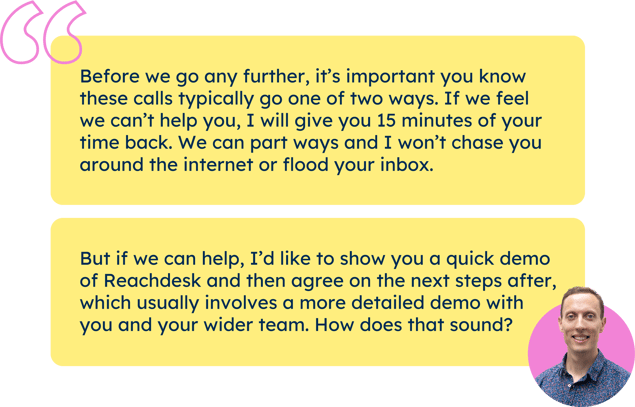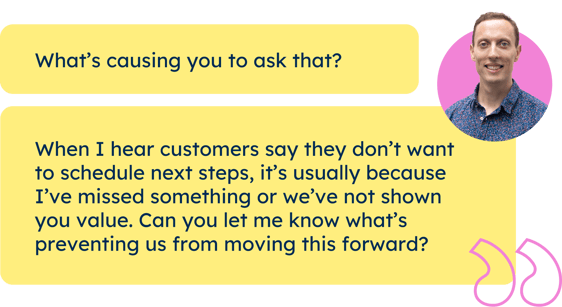Reachdesk Unwrapped: Deliver a winning sales demo in 8 steps
At Reachdesk, we love doing demos. We relish any opportunity to showcase what our product can do. Sure, the stakes are high, but when you believe in the product you’re selling and the story you’re telling, you’re bound to have interesting conversations that you can always learn something from, no matter the outcome.
Here’s my eight-step recipe for dishing up a delicious demo that moves deals forward and helps you close revenue.
Step 1: Prepare and prosper
The most important thing you can do in the lead-up to a demo is remember the 7 Ps: Proper Prior Preparation Prevents Piss-Poor Performance.
Thank heavens for LinkedIn. It’s pretty much a one-stop shop for researching a prospect’s role, strategic objectives, industry, and competitors. You should also look at the pain points affecting that particular industry, and be prepared to explain why life without your product presents even more challenges.
But preparation isn’t just learning soundbites you can rattle off during a meeting. You’ll also want to build a rapport with your prospect. Taking time to read their social media posts will give you an understanding of how they speak and what matters to them, enabling you to make an excellent first impression.
Step 2: Confirm next steps early on
Every sales rep has been there at one point: you’ve secured a meeting with your prospect, but the clock suddenly runs out and you realise you haven’t agreed on what the next steps should be. Now they’re itching to go to their next meeting – and your sales process runs the risk of losing steam.
That’s why it’s so important to establish an upfront contract (UFC) either before or at the beginning of every meeting. This agreement should touch on five aspects of your upcoming conversation:
- Its purpose
- Each individual’s agenda and expectations
- Time and location
- What the next steps should be (if there’s alignment)
Here’s my go-to pitch when deciding on next steps with a prospect:
Step 3: Show the big reveal
Do your research so you can pick up where your prospect’s discovery call left off and show them the most important details first. Start by outlining the specific challenges they’ve already mentioned, then introduce the solutions you’re going to show them for each one.
I believe that when people choose a software product, it’s not a certain feature or benefit that hooks them – but the story they’re told that captures the “why” behind the product. Great sales reps need to tell great stories, so prepare a compelling narrative that shows how your product fits their specific circumstances.
That’s not to say your demo is the time or place for a Crime & Punishment-esque tome. Customers want something to quickly sink their teeth into, so start with the big reveal and then work backwards.
Step 4: Give them a taste
According to fascinating research by revenue intelligence platform Gong, the ideal sales presentation is nine-minutes or less. We always stick to the nine-minute rule for our initial calls and it has served us well. Our goal is to show the prospect three main things before inviting them to a more detailed demo with the wider team.
Since you want to be respectful of the prospect’s time, you should focus only on the most relevant points. If you have a few minutes left on the clock, ask permission to show them more about the product.
Once you’ve covered the “why”, encourage your prospect to ask questions and to consider what other decision makers would need to know more about before they could proceed. This will help you flag potential blockers in advance.
Step 5: Disrupt the status quo
“Disruptive” is an everyday buzzword among startups and tech companies, but at its core, it represents a desire to change the status quo. That’s a strong narrative for a sales rep to have, especially if you can convince your prospect that the status quo is no longer an option.
Loss aversion is a human impulse to work twice as hard to avoid loss than we would to gain benefits. The loss felt from a valuable object can be profoundly worse than gaining that same thing.
You can play into this cognitive bias by focusing on the pains of the status quo and highlighting how your product can help the prospect avert loss down the line. In other words, it’s more powerful to tell someone that staying in point A is painful than telling them you can get them to point B.
Step 6: Control the conversation
By this point, you’ve outlined your UFC and set the tone for you leading the conversation. Keep it up. There are a few topics you’ll want to influence.
- Pricing: Don’t bring up pricing until you’ve established the value of the account.

- Objections: If your prospect takes issue with any part of your pitch, respond with questions.
 Of course, there’s a difference between controlling a conversation and dominating it. Take care to ensure your prospect knows you’re genuinely interested in their input and feels that their concerns are heard.
Of course, there’s a difference between controlling a conversation and dominating it. Take care to ensure your prospect knows you’re genuinely interested in their input and feels that their concerns are heard.
Step 7: Tailor your social proof
If you’re tempted to wheel out the big-name logos each and every time to woo prospects – don’t!
People instinctively gravitate towards relatable examples that they can emulate and follow. You wouldn’t just say “We work with Google, SAP and IBM” if you’re demoing to a 20-person startup. Showcasing your heavy hitters will likely alienate a chunk of your audience.
Part of your preparation for individual accounts should include pulling together case studies and use cases that are as relevant to your prospect’s company size, location, industry, and challenges as possible.
Step 8: Focus on before and after
As impressive as projected ROI can be, it’s not always the most compelling thing to dwell on during the sales process.
People love a good "before and after" story with stats and clear success metrics, so come equipped with case studies your prospects can relate to. After all, part of telling a great story is making sure your audience can see themselves in it.
Best of luck! I hope my tips help you to deliver insightful demos with clear agendas and outcomes. If you want a front row seat to a Reachdesk demo and really see us in action, we'd love to hear from you.